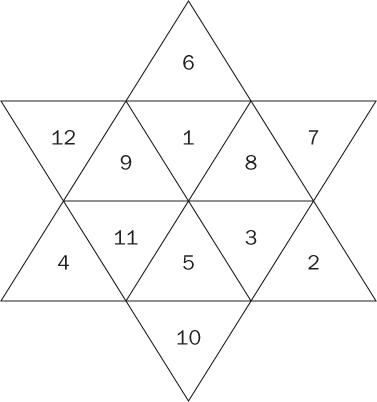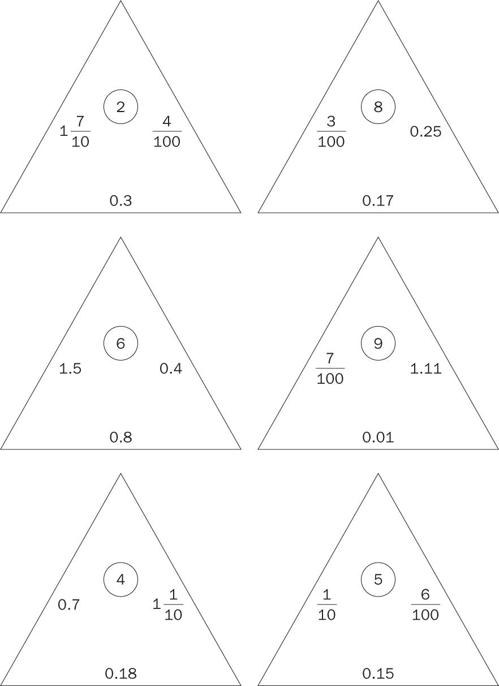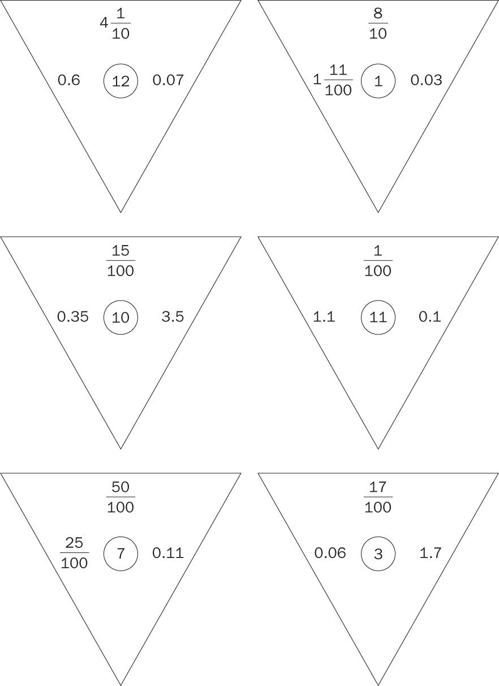Read Teaching the Common Core Math Standards With Hands-On Activities, Grades 3-5 Online
Authors: Judith A. Muschla,Gary Robert Muschla,Erin Muschla-Berry
Tags: #Education, #Teaching Methods & Materials, #Mathematics, #General
Teaching the Common Core Math Standards With Hands-On Activities, Grades 3-5 (40 page)

Activity 1: Matching Fractions and Decimals
Students will match a decimal with its equivalent fraction by arranging triangles, placing equivalent values on adjacent sides.
Materials
Scissors; reproducibles, “Fraction Triangles, I” and “Fraction Triangles, II,” for each student.
Procedure
1.
Explain that every fraction can be written as an equivalent decimal. Provide examples, such as the following:
2.
Distribute copies of the reproducibles. Explain that each reproducible has six triangles, which are identified by a circled number. Each side of every triangle has a fraction or a decimal. The 12 triangles can be arranged in a manner so that every fraction is paired with an equivalent decimal on sides that are next to each other. Note that some fractions or decimals will not have equivalent values on other triangles.
3.
Instruct your students to cut out the triangles and arrange them so that equivalent values are next to each other on adjacent sides of the triangles.
Closure
Discuss the arrangement of the triangles and the strategies students used to match equivalent fractions and decimals.
Answers
The number of each triangle is provided and indicates the triangle's position. By arranging the triangles in this manner, equivalent fractions and decimals will be on adjacent sides.
Activity 2: Locating Decimals on a Number Line
Working in pairs or groups of three, students will visit a Web site and virtually locate decimals on a number line.
Materials
Computers with Internet access for students; computer with Internet access and digital projector for the teacher.
Procedure
1.
Instruct your students to go to
www.mymaths.co.uk/samples/decimalLines.html
. Explain that students will be working with decimal values and a number line.
2.
Instruct them to click on number 1 on the left side of the screen. Students will see a number line ranging from 0 to 10. They should click on “Next” at the bottom left of the screen. Below the first number line they will now see a second number line with question marks. Each question mark represents a decimal. These decimals are located between the two numbers that the magnifying glass focuses on. Students should click on all of the question marks to reveal the values of the decimals.
3.
Instruct your students to click on number 2 on the left side of the screen. They will see a number line with decimals below it. Students are to drag the given numbers to their correct places. When they are finished, they should click on “Markit,” at the lower right of the screen. They will learn if they placed the decimals correctly; they should correct any decimals that they placed incorrectly.
4.
Tell your students to click on number 3 on the left side of the screen. Again, they will see a number line. They will also see markers (letters in boxes) and rules (in a box). The markers are matched to a rule by color. Students are to drag the markers according to the rules to their correct place on the number line. After dragging all of the markers, they should click on “Markit” to learn if they are correct. They should make any necessary corrections.
5.
Instruct your students to click on number 4 on the left side of the screen. They will see a number line, divided into tenths. They should click on “Next” to reveal a second number line, which shows a portion of the previous number line divided into hundredths. Clicking on each question mark will reveal a decimal with a digit in the hundredths place. Tell your students to click on number 5 on the left side of the screen. They are to drag the numbers to their correct places on the number line. When they are done, they should click on “Markit” to learn if they are correct. They should make any necessary corrections. (
Note:
After number 5, the scope of the material exceeds what is required by this Standard. However, depending on the abilities of your students, you may find it worthwhile to have them continue working through this Web site.)
Closure
Ask students to write an exit card explaining how to locate a decimal on a number line. Collect the exit cards. You may wish to share exceptional responses or clear up any misconceptions the next day.
Fraction Triangles, I
Fraction Triangles, II
Number and Operations—Fractions: 4.NF.7
“Understand decimal notation for fractions, and compare decimal fractions.”
7. “Compare two decimals to hundredths by reasoning about their size. Recognize that comparisons are valid only when the two decimals refer to the same whole. Record the results of comparisons with the symbolsor
and justify the conclusions, e.g., by using a visual model.”
Background
There are three ways students can compare decimals: using place value, using the number line, or making a model on graph paper.
To use place value for comparing decimals, students should compare the digits place by place. For example, to compare 0.24 and 0.3, start with the ones place. The ones are both 0. Go to the tenths place. In the first decimal there are 2 tenths, but in the second decimal there are 3 tenths. Because 3 tenths is larger than 2 tenths, It does not matter that there are more digits in 0.24 because the 4 represents hundredths. If a placeholder were added in the hundredths place for 3 tenths, the decimal would be 30 hundredths. In this case it is easy to see that
It does not matter that there are more digits in 0.24 because the 4 represents hundredths. If a placeholder were added in the hundredths place for 3 tenths, the decimal would be 30 hundredths. In this case it is easy to see that





